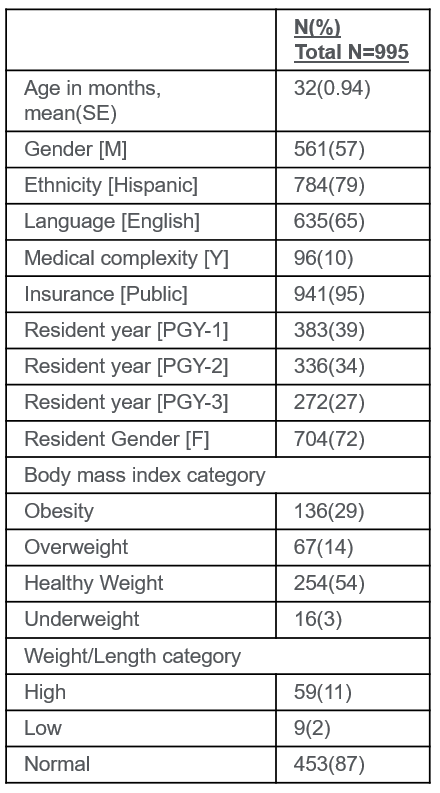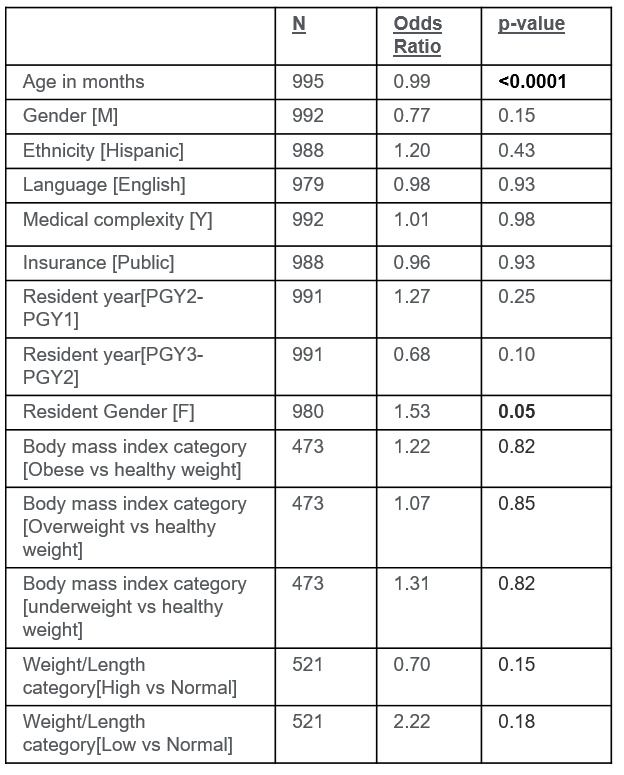Obesity
Category: Abstract Submission
Obesity I
505 - Cute kid? Use of non-medical descriptors in presentations by pediatric residents and patient obesity status.
Saturday, April 23, 2022
3:30 PM - 6:00 PM US MT
Poster Number: 505
Publication Number: 505.238
Publication Number: 505.238
Michael J. Cosimini, Oregon Health Sciences University, Portland, OR, United States; Kevin J. Fang, Children's Hospital Los Angeles, Los Angeles, CA, United States; Christina Jung, Children's Hospital Los Angeles, USC Keck School of Medicine, Los Angeles, CA, United States; Payal Shah, Children's Hospital Los Angeles, Los Angeles, CA, United States; Juan C. Espinoza, Children's Hospital Los Angeles, Los Angeles, CA, United States; Olga Solomon, Children's Hospital Los Angeles, Camarillo, CA, United States

Michael J. Cosimini, MD
Assistant Professor Pediatrics
Oregon Health and Science University
Portland, Oregon, United States
Presenting Author(s)
Background: Non-medical descriptors, adjectives that are not related to a medical condition such as “cute”, are often used in presentations in pediatrics. The significance, if any, of this language by pediatric trainees is not known. We hypothesized it’s use may reflect obesity bias.
Objective: This study describes non-medical descriptor use and assesses if there is variation in the use of these descriptors for children based on obesity status.
Design/Methods: Non-medical descriptors used by pediatric residents presenting children less than nine-years in a single outpatient clinic during the 2018-19 and 2019-20 academic years were recorded. These were recorded along with weight, length, and demographic factors of the patient and resident year in training and gender. The positive or negative valence of the descriptor was determined by the recording attending physician at the time of the presentation. The primary outcome was to measure the association of use of positive non-medical descriptors in children with obesity status (weight/length for children under two). Data analysis was performed using logistic regression and odds ratios were calculated.
Results: 995 of 1019 recorded presentations had complete weight and height data for analysis. Patient and resident demographics by encounter are described in table 1. Positive descriptors were used in 14%(144/995) and most addressed the appearance of the child with variations of “cute” and “adorable”. There was no variation in use of positive descriptors by obesity status or weight/length category in univariate analysis (Table 2). On multivariate logistic regression, the odds of using positive descriptors were 58% higher among female residents (OR=1.58, p=0.03) and odds of use of positive descriptors declined with patient age (Table 3). There was no difference in rates of use of positive non-medical descriptors for other secondary variables, including patient ethnicity, gender, primary language, medical complexity, or resident years in training (table 2). Negative descriptors were used in 1.2%(12/995) of encounters and often focused on weight with variations on, “chubby”, “big” and “large”. “Chubby” was categorized as both positive and negative in different encounters.Conclusion(s): Use of positive descriptors did not vary with patient obesity status. Positive non-medical descriptors were focused on appearance and declined with age in a pattern consistent with existing data on adults' perceptions of children’s cuteness. Variation was seen with resident gender but not any patient related factor other than age.
Table 1: Patient and resident demographics by encounter. Patient and resident demographics by encounter. Body mass index category is for encounters with children two years of age and older and weight for length category is for encounters with children less than two year of age.
Patient and resident demographics by encounter. Body mass index category is for encounters with children two years of age and older and weight for length category is for encounters with children less than two year of age.
Table 2: Univariate analysis of use of non-medical positive descriptors by patient and resident characteristics. Univariate analysis of patient and resident factors and use positive non-medical descriptors by encounter. Body mass index category is for encounters with children two years of age and older and weight for length category is for encounters with children less than two year of age.
Univariate analysis of patient and resident factors and use positive non-medical descriptors by encounter. Body mass index category is for encounters with children two years of age and older and weight for length category is for encounters with children less than two year of age.
Objective: This study describes non-medical descriptor use and assesses if there is variation in the use of these descriptors for children based on obesity status.
Design/Methods: Non-medical descriptors used by pediatric residents presenting children less than nine-years in a single outpatient clinic during the 2018-19 and 2019-20 academic years were recorded. These were recorded along with weight, length, and demographic factors of the patient and resident year in training and gender. The positive or negative valence of the descriptor was determined by the recording attending physician at the time of the presentation. The primary outcome was to measure the association of use of positive non-medical descriptors in children with obesity status (weight/length for children under two). Data analysis was performed using logistic regression and odds ratios were calculated.
Results: 995 of 1019 recorded presentations had complete weight and height data for analysis. Patient and resident demographics by encounter are described in table 1. Positive descriptors were used in 14%(144/995) and most addressed the appearance of the child with variations of “cute” and “adorable”. There was no variation in use of positive descriptors by obesity status or weight/length category in univariate analysis (Table 2). On multivariate logistic regression, the odds of using positive descriptors were 58% higher among female residents (OR=1.58, p=0.03) and odds of use of positive descriptors declined with patient age (Table 3). There was no difference in rates of use of positive non-medical descriptors for other secondary variables, including patient ethnicity, gender, primary language, medical complexity, or resident years in training (table 2). Negative descriptors were used in 1.2%(12/995) of encounters and often focused on weight with variations on, “chubby”, “big” and “large”. “Chubby” was categorized as both positive and negative in different encounters.Conclusion(s): Use of positive descriptors did not vary with patient obesity status. Positive non-medical descriptors were focused on appearance and declined with age in a pattern consistent with existing data on adults' perceptions of children’s cuteness. Variation was seen with resident gender but not any patient related factor other than age.
Table 1: Patient and resident demographics by encounter.
 Patient and resident demographics by encounter. Body mass index category is for encounters with children two years of age and older and weight for length category is for encounters with children less than two year of age.
Patient and resident demographics by encounter. Body mass index category is for encounters with children two years of age and older and weight for length category is for encounters with children less than two year of age.Table 2: Univariate analysis of use of non-medical positive descriptors by patient and resident characteristics.
 Univariate analysis of patient and resident factors and use positive non-medical descriptors by encounter. Body mass index category is for encounters with children two years of age and older and weight for length category is for encounters with children less than two year of age.
Univariate analysis of patient and resident factors and use positive non-medical descriptors by encounter. Body mass index category is for encounters with children two years of age and older and weight for length category is for encounters with children less than two year of age.